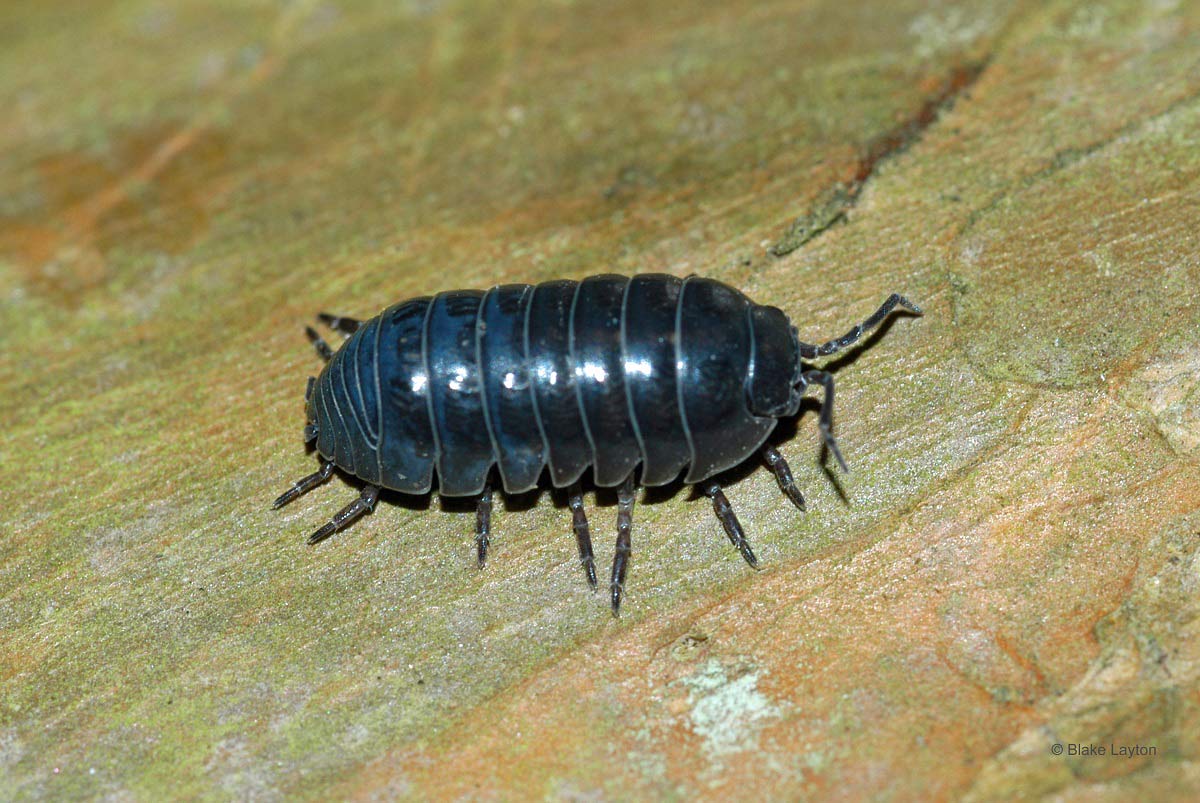Pillbugs, Vol. 6, No. 24

Common Pillbug
Armadillidium vulgare
Order: Isopoda
Family: Armadillidiidae
Children love roly-polies. They are slow-moving and easy to catch; they tickle as they crawl across your hand, and they can roll up into neat little balls. They’re cute, curious little creatures. These aren’t insects, but they are often some of the first arthropods young children encounter and are allowed to handle, providing early exposure to the wonders of nature and the mysteries of biology.
Also known as common pillbugs and a host of other colloquial names, roly-polies belong to a special group of arthropods, known as isopods, a subgroup of crustaceans (shrimp, crabs, lobsters). Arthropods have the world neatly divided among themselves. The crustaceans have the oceans, and the insects and arachnids have the land. Of course, there are a few exceptions. Like other crustaceans, most isopods are aquatic, with most species living in saltwater, but pillbugs and sowbugs are land-dwellers. Sowbugs look a lot like pillbugs, but sowbugs are unable to roll into a ball. Bathynomus giganteus is a deep sea-dwelling isopod that looks like a giant pillbug, with some specimens growing to over a foot long.
Many gardeners are surprised to learn pillbugs are not native to the US. After all, they have been here all our lives. Thought to have originated from Europe, pillbugs occur through much of the world. They came to be so widely distributed because they can easily hitch rides in shipments of potted plants and other plant material.
Their Latin name is perfect for them; “vulgare” means common, and “Armadillidium” refers to their armored bodies and their ability to roll into a protective ball, traits they share with the nine-banded armadillo. Pillbugs also have something in common with kangaroos. Female pillbugs nurture their young in a special abdominal pouch known as the marsupium. They even produce a special nutritive fluid for young pillbugs to feed on until they leave the marsupium. It’s roly-poly milk! Some unfortunate pillbugs even have something in common with Smurfs. They are blue, sometimes a vivid bright blue. This is caused by an uncommon, lethal virus infection that causes the infected pillbug to reflect blue light.
Are pillbugs pests? Not usually. Pillbugs primarily feed on decaying plant material and are considered beneficial because they help recycle nutrients. Occasionally pillbugs feed on tender young plants and fruit that is in close contact with the soil. In this way they sometimes cause minor damage to things like young ornamental bedding plants; hosta leaves emerging through mulch or leaf litter in the spring; lower leaves of lettuce; cucumbers and strawberries and emerging seedlings of vegetable and row crops, especially crops grown under no-till production.
But slugs also damage plants in such situations and are more often the cause of such damage. If you find slime trails blame slugs. Pillbugs can also be a minor nuisance when they wander into homes and buildings.
Control: Cultural practices, such as avoiding excessive moisture and minimizing leaf litter and other decaying organic matter around sensitive sites is often all that is needed to control pillbugs. Just raking mulch away from emerging hosta can prevent damage to young leaves. Some companies sell “bug and slug” baits that will control pillbugs as well as slugs but check label before using around edible plants. Good exclusion practices around door thresholds and other potential entry points is the most important step toward keeping pillbugs and other occasional invading insects and spiders out of buildings.
Blake Layton, Extension Entomology Specialist, Mississippi State University Extension Service.
The information given here is for educational purposes only. Always read and follow current label directions. Specific commercial products are mentioned as examples only and reference to specific products or trade names is made with the understanding that no discrimination is intended to other products that may also be suitable and appropriately labeled.
Mississippi State University is an equal opportunity institution.

